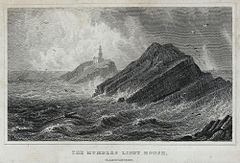Mumbles(Welsh:Mwmbwls) is a headland sited on the western edge ofSwansea Bayon the southern coast ofWales.

Toponym
editMumbles has been noted for itsunusual place name.[1]The headland is thought by some to have been named by French sailors, after the shape of the two anthropomorphic islands which the headland comprises: the word "Mumbles" may be a corruption of the Frenchles mamelles,meaning "the breasts". Another possible source of the name is the wordMamucium,which is generally thought to represent a Latinisation of an originalBrythonicname, either from mamm- ( "breast", in reference to a "breast-like hill" ) or from mamma ( "mother", in reference to a local river goddess).[citation needed]
Mumbles Lighthousewas built during the 1790s, and was converted to solar powered operation in 1995.[2]
Notable features
editMumbles Pierwas opened in 1898 at the terminus of theSwansea and Mumbles Railway,which was the world's first horse-drawn public passenger train service. It opened 2 Mar 1807 and used horse power to 1877, then steam power to 1929, when it switched to double deck overhead electric tram power, lasting till the line closed in Jan 1960.[3]
Mumbles Lifeboat Stationhas operated since 1866. In 1947, the entire lifeboat crew was lost at sea, attempting to rescue the crew of theSS Samtampa,in what has become known as theMumbles lifeboat disaster.The nearest church,All Saints' Church, Oystermouth,contains memorials to the crew.
Climate
edit| Climate data for Mumbles Head (32m elevation) 1981–2010 | |||||||||||||
|---|---|---|---|---|---|---|---|---|---|---|---|---|---|
| Month | Jan | Feb | Mar | Apr | May | Jun | Jul | Aug | Sep | Oct | Nov | Dec | Year |
| Mean daily maximum °C (°F) | 8.0 (46.4) |
7.8 (46.0) |
9.5 (49.1) |
11.9 (53.4) |
15.0 (59.0) |
17.7 (63.9) |
19.6 (67.3) |
19.7 (67.5) |
17.8 (64.0) |
14.4 (57.9) |
11.1 (52.0) |
8.7 (47.7) |
13.5 (56.3) |
| Mean daily minimum °C (°F) | 4.0 (39.2) |
3.6 (38.5) |
4.8 (40.6) |
6.3 (43.3) |
9.2 (48.6) |
11.8 (53.2) |
13.9 (57.0) |
14.0 (57.2) |
12.4 (54.3) |
9.9 (49.8) |
6.9 (44.4) |
4.7 (40.5) |
8.5 (47.3) |
| Average rainfall mm (inches) | 95.5 (3.76) |
67.0 (2.64) |
72.9 (2.87) |
58.5 (2.30) |
62.8 (2.47) |
63.8 (2.51) |
71.9 (2.83) |
83.9 (3.30) |
77.4 (3.05) |
123.1 (4.85) |
112.1 (4.41) |
110.3 (4.34) |
999.2 (39.34) |
| Average rainy days(≥ 1.0 mm) | 15.0 | 11.0 | 13.5 | 10.6 | 10.3 | 9.9 | 10.1 | 11.2 | 11.4 | 15.4 | 15.0 | 14.4 | 147.9 |
| Source: metoffice.gov.uk[4] | |||||||||||||
See also
edit- Mumbles (district),a district of Swansea
- Mumbles RFC
- Breast-shaped hill
References
edit- ^Symons, Mitchell (8 November 2012).The Bumper Book For The Loo: Facts and figures, stats and stories – an unputdownable treat of trivia.Transworld. p. 272.ISBN978-1-4481-5271-1.
- ^"Mumbles".Archived fromthe originalon 3 December 2013.
- ^"The Swansea and Mumbles Railway - the world's first railway service".
- ^"Climate Normals 1981–2010".Met Office.Retrieved24 February2021.
External links
edit